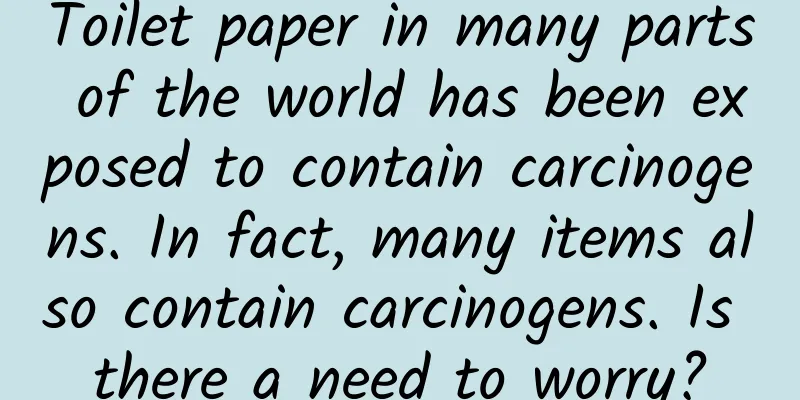Toilet paper in many parts of the world has been exposed to contain carcinogens. In fact, many items also contain carcinogens. Is there a need to worry?

|
Recently, the British newspaper The Guardian reported that a class of toxic and harmful substances were detected in the toilet paper used daily by residents in many parts of the world. It is reported that this class of substances is likely to cause cancer. Many friends couldn't help but feel their anus tightened after hearing this news. Is it unsafe to go to the toilet in the future? What exactly is this substance? What other common items in daily life might contain it? Is its harm to health real or just a myth? First of all, this substance does exist, or more precisely, it is a class of substances, scientifically known as per- and polyfluoroalkyl substances (PFAS). It refers to organic compounds containing at least one perfluorinated carbon atom (i.e., at least one -CF2- or -CF3- fatty chain structural unit). Currently, there are more than 1,400 known species, of which perfluorooctanoic acid (PFOA) and perfluorooctane sulfonic acid (PFOS) are relatively common. What are PFAS used for? How can we come into contact with them in our daily lives? Its shadow is everywhere in our lives. It is a kind of artificially synthesized chemical substance with the characteristics of hydrophobicity and oleophobicity, high temperature resistance, and the ability to reduce the surface tension of water. Adding it to the product can obtain the ability of oil repellency, water repellency, anti-fouling and anti-mud, chemical resistance and high temperature resistance, reducing surface friction, surface activity, etc. Based on this, this type of compound has become the darling of the processing and manufacturing industry since its introduction. It not only has a long application history, but also has a wide range of applications. From large-scale aircraft and automobile manufacturing to small-scale dental floss and contact lenses, it can be found in almost every scene in life that you can imagine. Can you guess that PAFS may be contained in these items? For example, the packaging materials of food purchased from supermarkets (paper and cardboard for food contact), the leather and clothing you wear, the pans and non-stick cookware (such as Teflon) used in the kitchen, the waterproof fabrics and carpets on the floor, the lubricants and pesticides used in agricultural production, the tents, raincoats, and sunscreens used for outdoor sports, as well as daily detergents, polishes, paints, cleaning products, and fire-retardant foams, all of these items actually contain PAFS. This means that as long as you are alive, it is difficult not to be exposed to them. Taking cosmetics as an example, a survey by the U.S. Environmental Science and Technology Communications found that 56% of the foundation creams and eye shadow products, 48% of the lipsticks, and 47% of the mascaras sold in the U.S. and Canadian markets contain PFAS. This is why more and more people are beginning to worry. After all, it is too close to our lives, so close that it is difficult to detect. If there are really problems with safety, the damage to health will be like a drop of water wearing away a stone. Is this substance really harmful? What effects will it cause? There have been reports about the health risks of PFAS for a long time. For example, in November 2022, a Japanese group announced that per- and polyfluoroalkyl substances were detected in the well water used as a tap water source in the Tama area of Tokyo, and blood tests for residents have been initiated, but no definite results have been obtained. More importantly, the World Health Organization has not yet concluded whether it is harmful. The reason why it is considered a possible health threat is mainly related to the following factors. First, it is extremely stable and not easy to decompose. Since the molecular structure of PFAS is a short-chain, medium-chain or long-chain molecule composed of carbon and fluorine elements, the bond between carbon and fluorine is very stable, and it is extremely difficult to decompose both in the natural environment and in the body, so it is called a "permanent chemical." Second, it is mobile in the environment and may cause global pollution. It can migrate through water, air, soil, and food chains. Third, it is bioaccumulative, and the higher up the food chain, the more it accumulates. Because it is widely present in the environment and cannot be decomposed, it will continue to accumulate in the food chain cycle. Fourth, there may be certain toxicity. Some studies have shown that FPAS compounds are harmful to both life and the environment, and more types of compounds need to be analyzed. How big a threat does it pose to human health? Although there is some evidence that it may have health effects on human health, there is still a lack of direct and effective evidence. The current evidence is mainly based on environmental monitoring and animal research. On the one hand, there is the problem of exposure to FPAS compounds in the environment. Even though there has been no systematic record of FPAS for a long time, they have been detected in water and soil in many countries and regions, including Germany and Japan. On the other hand, some animal studies suggest that there may be health damage. Studies have found that PFAS and PFOS can affect animal reproduction and development, liver, kidneys and immune system, and may also induce tumors, such as kidney cancer and testicular cancer. Some scholars worry that if humans ingest PFAS, it will stay in the human body for a long time, and over time, the level of PFAS in the body may increase to a level that is detrimental to health. The key to the problem is, to what extent will the enrichment be harmful? What harm will it cause? At present, the most consistent finding in epidemiological surveys is the increase in cholesterol levels in exposed populations, while the evidence for its effects on infant birth weight, immune system, cancer, and thyroid hormone interference is very limited. How should we deal with it in life? We should neither be paranoid nor complacent. Although many countries and regions, including the European Union, have applied to restrict the production and use of such substances, no consensus has been reached, and the World Health Organization continues to pay attention to the safety of the substance. There is no need to be afraid. On the one hand, there is no definite evidence of harm. Even if you use toilet paper, toothpicks and other items containing PFAS in your daily life, they will not enter the body. On the other hand, the items just mentioned still play an important role in our lives. Before there is a substitute, I am afraid they will not be completely restricted in the short term. However, it is still recommended that everyone try to simplify their lives and enjoy a healthy, low-carbon lifestyle. At the same time, pay more attention to some popular science knowledge to avoid panic caused by certain information. |
>>: Are bananas the "feces pusher" of the intestines? You need these foods to have a pleasant poop
Recommend
Does the sun also have "tsunamis"? New research may have solved the mystery of "tsunamis" in the solar chromosphere
There is such a horrifying scene in the Chinese s...
How to build a user operation system?
Whether it is offline training or online classes,...
Strategy for building an APP user incentive system
In product operation, the user incentive system i...
"Food Safety Guide" Series | Chinese medicine says tea, are you drinking it right?
When I was a kid, I only heard of two kinds of te...
Product Analysis Report | Analysis of Mango TV Membership System
With the continuous development of the video indu...
Using Cocoa Layout Instrument to inspect automatic layout
Some time ago, MarkD discussed with us many usefu...
Double 11’s 268.4 billion, the most authentic marketing insights
It is no exaggeration to say that Tmall Double 11...
How to buy traffic and acquire users on Douyin at low cost?
Tik Tok is still in its wild growth period, with ...
Summary of 5 years of data product experience: 3 questions about user growth
The essence of user growth is to conduct precise ...
Scientists have calculated that there are 200 trillion ants in the world. What does this mean?
People only know that there are a lot of ants, bu...
The biggest bottleneck of mobile devices: How to break through the battery?
ReadWrite, a US technology blog, recently wrote an...
2022 Veterans’ Academic Advancement Policy: What are the benefits?
Every soldier contributes his own part to the cons...
Drink bone soup to supplement calcium? This article tells you how effective it is
Can bone soup provide calcium? The calcium in bon...
Summary of common configurations of Android gradle
This article summarizes the common configurations...
The Secret of APP Mother and Baby Products Community Operation
The development of online communities has gone th...









